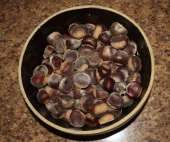


Donna Lynn wrote:
Pearl Sutton wrote:
Nina Surya wrote:
Did you get to be a vet assistant with or without diploma's? Asking for ... me!
I did vet assistant many many years ago, and it was basically "Are you a warm body that can clean cages, not freak out with upset animals, hand me things, be useful? You are hired!" No idea if that's still valid, but it used to be that way.
Same for me, basically. I was in 10th grade and thought I'd hit the jackpot working with animals... then I found out the vet paid less than legal minimum wage because "so many people want to work with animals that I don't have to pay that much and always have a waiting list." I did everything from clean cages to assist in surgeries. By the time I quit to pursue extracurricular school activities I felt that I could do a spay surgery by myself, I had assisted in so many. There were downsides though, such as too many healthy pets being "put to sleep" just because their owners paid for it and might get upset if they saw their former pet enjoying life in someone else's yard after they paid to have them killed. I begged to take home one dog who was friendly, gorgeous, healthy and playful. Of course my parents would have nixed it even if the vet had said yes, but the vet eventually gave him the lethal injection after we played with him and gave him love for several days after he was dropped off for euthanasia.

Andrew Welser wrote:
A human being should be able to change a diaper, plan an invasion, butcher a hog, conn a ship, design a building, write a sonnet, balance accounts, build a wall, set a bone, comfort the dying, take orders, give orders, cooperate, act alone, solve equations, analyze a new problem, pitch manure, program a computer, cook a tasty meal, fight efficiently, die gallantly. Specialization is for insects.
--Robert A. Heinlein
For me, it's been difficult to hold a career path: I want to change jobs every few years because I'm getting board and want to learn something new.



Rick Valley wrote:I grew up in the NE: New York, Ohio, and moved into the East Coast, New England, Maryland. I'm used to going t the Farmers Market and getting fresh roasted chestnuts, or roasting them in the fireplace. It's always fun to leave one un-pierced, so it POPS!
If you have the time, roasting, peeling and maybe slicing them into cassaroles and stir fries. Or boil them and make cream of chestnut soup. But most definitely: Turkey Stuffing on Thanksgiving, with Celeriac and red pepper slices* that's un poco picante pero dulce. *slices must be of a size to have a reasonable stuffing texture: not too big but distinct, not minced. Dammit, I've planted chestnuts all over, and here in Eugene I don't know any trees to gather from. I'll just have to buy some.

Brian Cady wrote:There are different types, which are best prepared differently:
European & American are great roasted quickly at high temperatures, after cutting through the shell.
Chinese chestnuts are starchier, typically, and best roasted slowly at low temperatures, without cutting the shell.
Below is James Nave's Chinese chestnut cooking guide:
Brian
-
How to Cook Chinese Chestnuts – J. M. Nave
If you have some favorite way of cooking Chinese chestnuts, I'm not trying to change that. I'm just trying to show people how you can best bring out the flavors of Chinese nuts and get better textures. Cooking Chinese nuts the same way you would cook European or American nuts is not optimal because Chinese nuts are much denser. And if you are cooking Chinese nuts optimally, you don't need to cut the shell. Low and slow is the optimal way to cook Chinese chestnuts.
The most interesting way, and most common way, to cook chestnuts in China is to roast chestnuts at low temperatures (240F or less) for extended periods of time (60 minutes or more). Roasting at lower temperatures for longer periods of time breaks down the dense Chinese nut and fully releases the flavors in the nut. It also gives the nut a softer texture, more like an American or European chestnut. A Chinese chestnut that is cooked at 350F or above for short periods of time (30 minutes or less), will normally have a burnt or hard exterior and an almost uncooked interior. The flavor will not be well developed. Cooking Chinese chestnuts in this manner has led to the common belief in the US that Chinese nuts are inferior to American or European chestnuts. American and European chestnuts that are cooked at high temperatures for short periods or time will be mostly cooked and falling apart and the flavors will be well developed. Because Chinese chestnuts are much denser than American and European chestnuts, they benefit from slower more thorough cooking at lower temperatures. Their density also gives Chinese nuts greater versatility in cooking. For example, Chinese chestnuts can be used in many dishes such as soups and stews without falling apart.
To fully understand how the density of the nut impacts cooking, it may be helpful to compare cooking chestnuts to cooking beef. Different cuts of beef have different textures and densities. Tenderloin (so named because of the soft texture of the meat) is quite different than brisket. Tenderloin may be cooked at high temperatures for short periods of time. The result is beef that is soft and full of flavor. Brisket on the other hand is a much denser cut of meat. Cooking it at high temperatures for short periods of time will result in a burnt exterior and an uncooked interior. The meat will also be tough and difficult to chew. To properly cook brisket requires cooking for longer periods of time at lower temperatures to allow the heat to penetrate to the interior of the meat. This results in a much more flavorful brisket with a softer texture. Chinese chestnuts are the brisket of the chestnut world. They are exceptionally good eating when properly cooked.
Another benefit to cooking Chinese chestnuts at lower temperatures is that the shells do not need to be cut. In the US, chestnut shells are normally cut when nuts are to be roasted to allow heated water vapor to escape. If the shell is not cut, the expanding water vapor will cause the shell to explode. But when a Chinese chestnut is cooked at 240F or below, it will not normally explode because the buildup of water vapor is very slow and it can escape without exploding the shell. This also results in another benefit. When the shell is not cut, the cooked nut retains more moisture which results in a better texture for the nut. To some extent, not cutting the shell also results in a partial steaming of the nut. It’s simply a better way to cook Chinese chestnuts. Which brings up the point that Chinese chestnuts can also be cooked by boiling for at least 60 minutes. Boiling is not optimal for American or European chestnuts because the nuts tend to get very soggy and fall apart which also makes them difficult to peel. Because Chinese nuts are denser, they don’t absorb much water and tend not to fall apart after boiling, which also makes them as easy to peel after boiling as they are before boiling.

Leigh Tate wrote:My neighbor gifted me with a bunch of chestnuts. I've never had them before. So except for the old seasonal song that mentions them roasting by an open fire, I don't know what to do with them. I tried one raw but wasn't too keen on that. Does anyone have some ideas to share? Recipes?

Cassie Martin wrote:I don't know if they do this everywhere, but potatoes are tenacious where I live. If you miss just one or two little potatoes, they grow big, healthy plants next year. There are potatoes growing in the lawn areas where we had garden beds years ago. They could hypothetically be harvested any time, you would just need to know where they were in the winter.